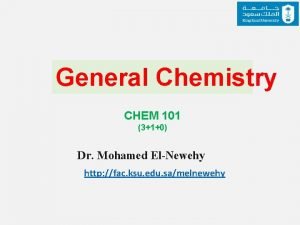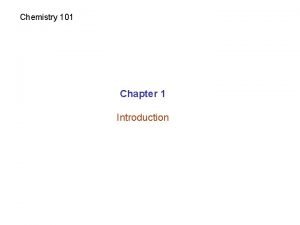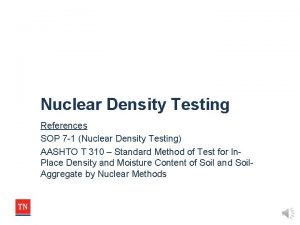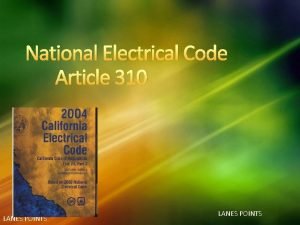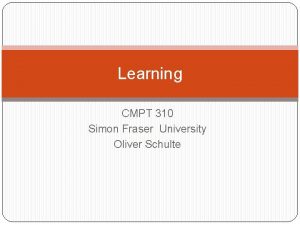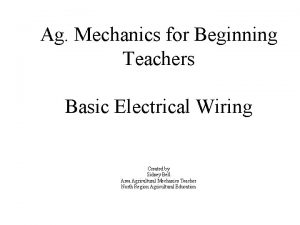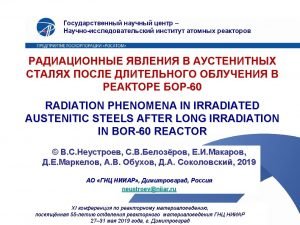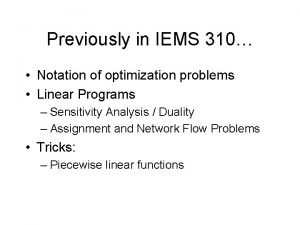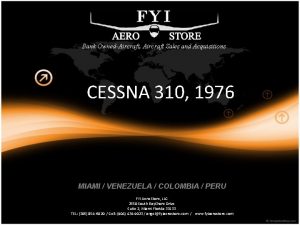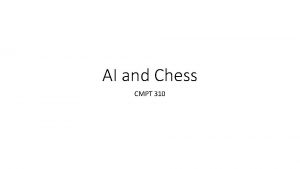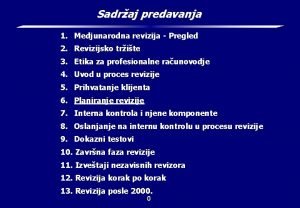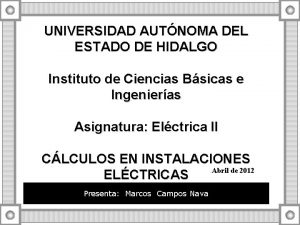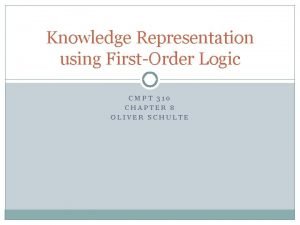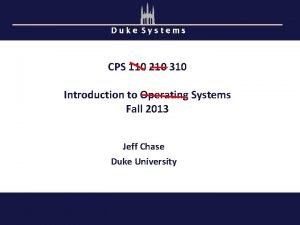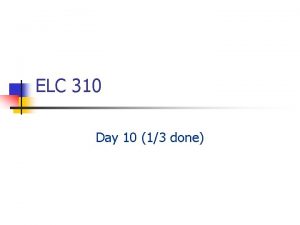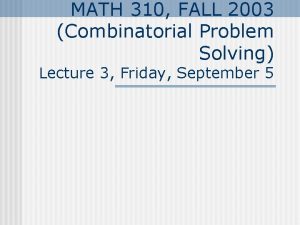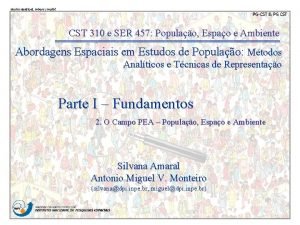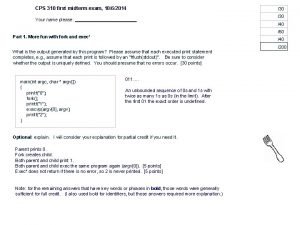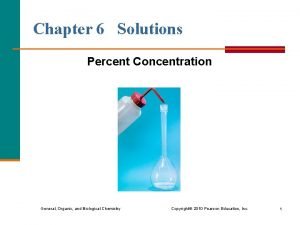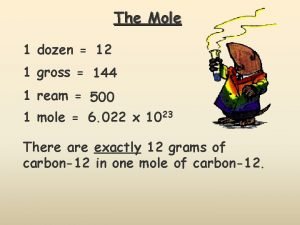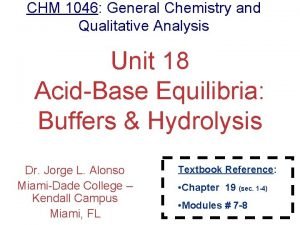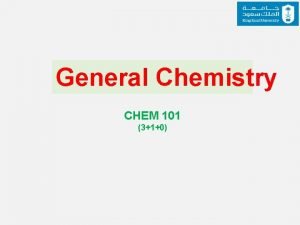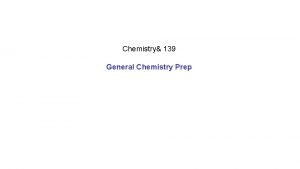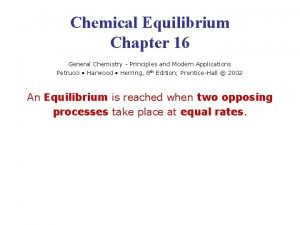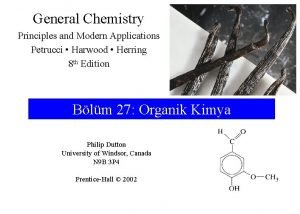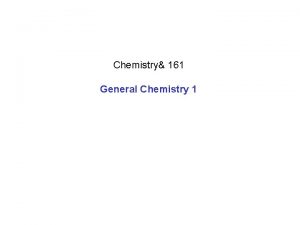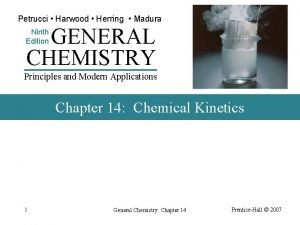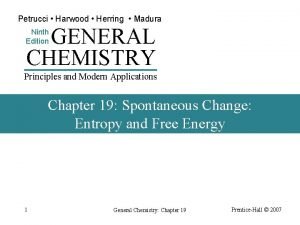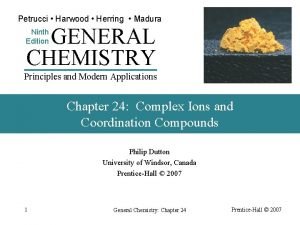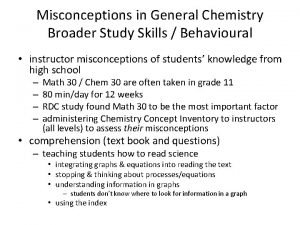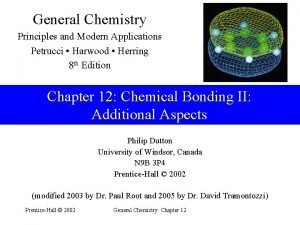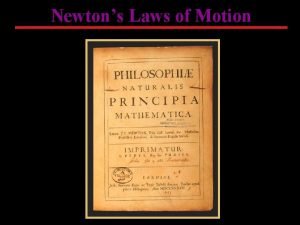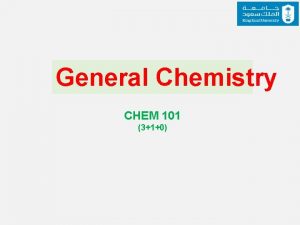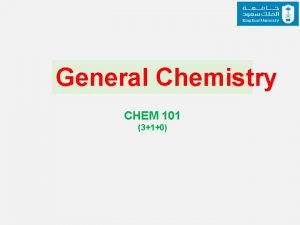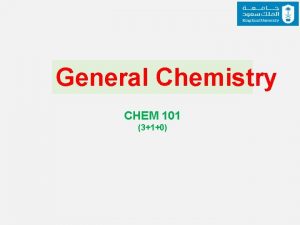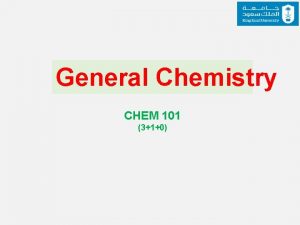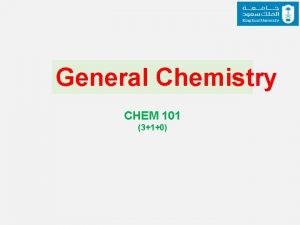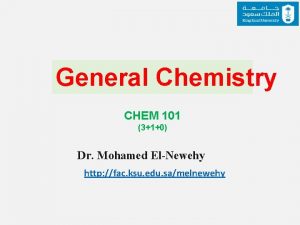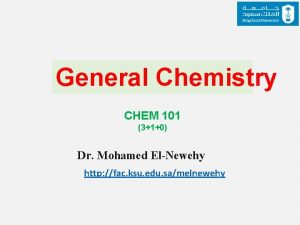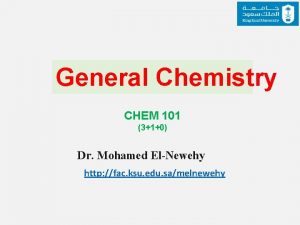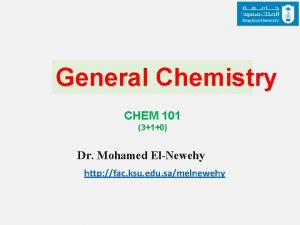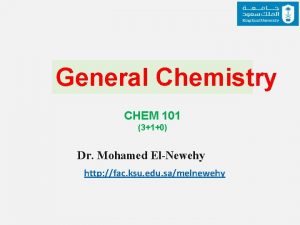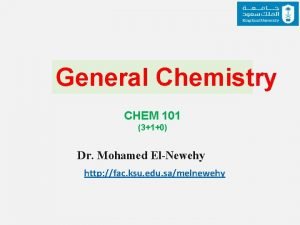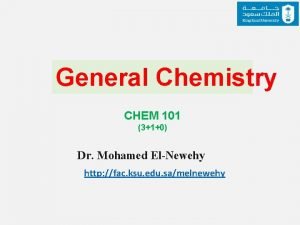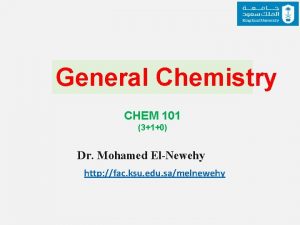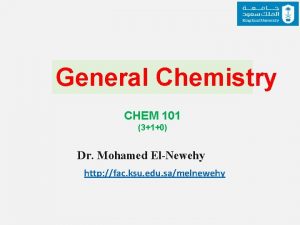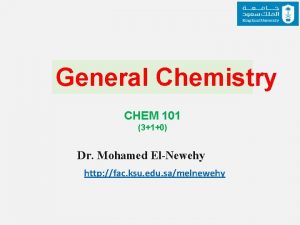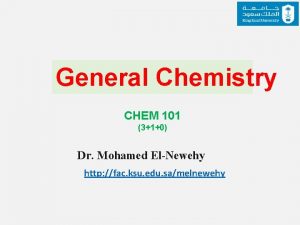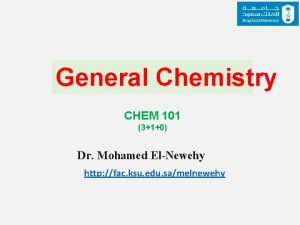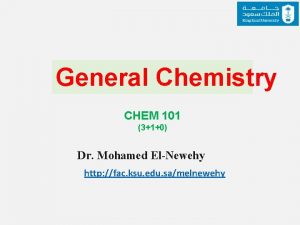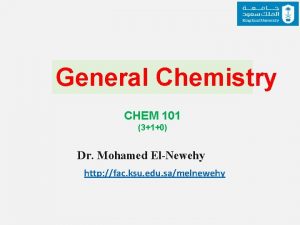General Chemistry CHEM 101 310 Chapter 3 Mass





















































- Slides: 53

General Chemistry CHEM 101 (3+1+0) Chapter 3 Mass Relationships in Chemical Reactions

In this chapter, Chemical structure and formulas in studying the mass relationships of atoms and molecules. To explain the composition of compounds and the ways in which composition changes.

Atomic Mass: Average Atomic Mass o The mass of an atom depends on the number of electrons, protons, and neutrons it contains. o Knowledge of an atom’s mass is important in laboratory work. Micro World atoms & molecules Macro World grams Atomic mass (atomic weight) is the mass of an atom in atomic mass units (amu). By definition: 1 atom 12 C “weighs” 12 amu On this scale 1 H = 1. 008 amu 16 O = 16. 00 amu

Atomic Mass: Average Atomic Mass The average atomic mass is the weighted average of all of the naturally occurring isotopes of the element.

Atomic Mass: Average Atomic Mass Naturally occurring lithium is: 7. 42% 6 Li (6. 015 amu) 92. 58% 7 Li (7. 016 amu) Average atomic mass of lithium: 7. 42 x 6. 015 + 92. 58 x 7. 016 100 = 6. 941 amu

Atomic Mass: Average Atomic Mass

Atomic Mass: Average Atomic Mass

Avogadro's Number and the Molar Mass of an Eleme The mole (mol): A unit to count numbers of particles Dozen = 12 Pair = 2 The mole (mol) is the amount of a substance that contains as many elementary entities as there atoms in exactly 12. 00 grams of 12 C This number is expressed by the Avogadro’s number (NA) 1 mol = NA = 6. 0221367 x 1023

Avogadro's Number and the Molar Mass of an Eleme Molar mass (M) is the mass of 1 mole of atoms in grams. 1 mole 12 C atoms = 6. 022 x 1023 atoms = 12. 00 g 1 12 C atom = 12. 00 amu 1 mole 1 H atoms = 6. 022 x 1023 atoms = 1. 00 g 1 1 H atom = 1. 00 amu For any element atomic mass (amu) = molar mass (grams)

Avogadro's Number and the Molar Mass of an Eleme • Unit is the amu mass. • atomic unit • 1 amu = 1. 66 x 10 -24 g • We define the masses of atoms in terms of atomic mass units • 1 Carbon atom = 12. 01 amu, • 1 Oxygen atom = 16. 00 amu • 1 O 2 molecule = 2(16. 00 amu) = 32. 00 amu

Avogadro's Number and the Molar Mass of an Eleme One Mole of: S C Hg Cu Fe

Avogadro's Number and the Molar Mass of an Eleme For example: Molar mass of 12 C is 12. 01 g and there are 6. 022 X 1023 atoms in 1 mole of the substance; The mass of one 12 C atom is given by 12 C 12. 00 g 12 C atoms 6. 022 x 1023 12 C atoms Mass of g 12 C atom 12. 00 g 12 C atoms 6. 022 x 1023 12 C atoms = 1. 993 x 10 -23 g

Avogadro's Number and the Molar Mass of an Eleme Avogadro’s number can be used to convert from the atomic mass units to mass in gram and vice versa. The mass of every 12 C atom = 12 amu The number of atomic mass units equivalent to 1 g is 1 12 C atom 12. 00 amu x 12. 00 g 6. 022 x 1 amu = 1. 66 x 10 -24 g M = molar mass in g/mol NA = Avogadro’s number 1023 12 C or atoms = 1. 66 x 10 -24 g 1 amu 1 g = 6. 022 x 1023 amu

Avogadro's Number and the Molar Mass of an Eleme

Avogadro's Number and the Molar Mass of an Eleme

Avogadro's Number and the Molar Mass of an Eleme

Avogadro's Number and the Molar Mass of an Eleme How many atoms are in 0. 551 g of potassium (K) ? 1 mol K = 39. 10 g K 1 mol K = 6. 022 x 1023 atoms K 0. 551 g K 1 mol K x 39. 10 g K 6. 022 x 1023 atoms K x 1 mol K 8. 49 x 1021 atoms K =

Molecular Mass Molecular mass (or molecular weight) is the sum of the atomic masses (in amu) in a molecule. 1 S 2 O 32. 07 amu + 2 x 16. 00 amu SO 2 64. 07 amu For any molecule molecular mass (amu) = molar mass (grams) 1 molecule SO 2 = 64. 07 amu 1 mole SO 2 = 64. 07 g SO 2 Molecular mass of H 2 O is

Molecular Mass

Molecular Mass

Molecular Mass

Molecular Mass How many H atoms are in 72. 5 g of C 3 H 8 O ? 1 mol C 3 H 8 O = (3 x 12) + (8 x 1) + 16 = 60 g C 3 H 8 O 1 mol C 3 H 8 O molecules = 8 mol H atoms 1 mol H = 6. 022 x 1023 atoms H 72. 5 g C 3 H 8 O 1 mol C 3 H 8 O x 60 g C 3 H 8 O 8 mol H atoms 6. 022 x 1023 H atoms x x 1 mol C 3 H 8 O 1 mol H atoms 5. 82 x 1024 atoms H =

Molecular Mass Formula mass is the sum of the atomic masses (in amu) in a formula unit of an ionic compound. Na. Cl 1 Na 22. 99 amu 1 Cl Na. Cl + 35. 45 amu 58. 44 amu For any ionic compound formula mass (amu) = molar mass (grams) 1 formula unit Na. Cl = 58. 44 amu 1 mole Na. Cl = 58. 44 g Na. Cl

Molecular Mass What is the formula mass of Ca 3(PO 4)2 ? 1 formula unit of Ca 3(PO 4)2 3 Ca 3 x 40. 08 2 P 8 O 2 x 30. 97 + 8 x 16. 00 310. 18 amu

Percent Composition of Compounds The percent composition by mass is the percent by mass of each element in a compound. n is the number of moles of the element in 1 mole of the compound %C = %H = %O = C 2 H 6 O 2 x (12. 01 g) 46. 07 g 6 x (1. 008 g) 46. 07 g 1 x (16. 00 g) 46. 07 g x 100% = 52. 14% x 100% = 13. 13% x 100% = 34. 73% 52. 14% + 13. 13% + 34. 73% = 100. 0%

Percent Composition of Compounds Given the percent composition by mass of a compound, we can determine the empirical formula of the Compound.

Percent Composition of Compounds Percent Composition and Empirical Formulas Given the percent composition by mass of a compound, we can determine the empirical formula of the Compound. Determine the empirical formula of a compound that has the following percent composition by mass: K 24. 75, Mn 34. 77, O 40. 51 percent. 1 mol K n. K = 24. 75 g K x = 0. 6330 mol K 39. 10 g K n. Mn = 34. 77 g Mn x 1 mol Mn = 0. 6329 mol Mn 54. 94 g Mn n. O = 40. 51 g O x 1 mol O = 2. 532 mol O 16. 00 g O

Percent Composition of Compounds Percent Composition and Empirical Formulas n. K = 0. 6330, n. Mn = 0. 6329, n. O = 2. 532 K: 0. 6330 ~ ~ 1. 0 0. 6329 = 1. 0 Mn : 0. 6329 2. 532 ~ O: ~ 4. 0 0. 6329 KMn. O 4

Percent Composition of Compounds Percent Composition and Empirical Formulas

Percent Composition of Compounds Percent Composition and Empirical Formulas

Percent Composition of Compounds To know the actual mass of an element in a certain mass of a compound.

Experimental Determination of Empirical Formulas Combust 11. 5 g ethanol Collect 22. 0 g CO 2 and 13. 5 g H 2 O g CO 2 mol C g. C 6. 0 g C = 0. 5 mol C g H 2 O mol H g. H 1. 5 g H = 1. 5 mol H g of O = g of sample – (g of C + g of H) 4. 0 g O = 0. 25 mol O Empirical formula C 0. 5 H 1. 5 O 0. 25 Divide by smallest subscript (0. 25) Empirical formula C 2 H 6 O

Experimental Determination of Empirical Formulas Thus, 11. 5 g of ethanol contains 6. 00 g of carbon and 1. 51 g of hydrogen. The remainder must be oxygen, whose mass is The number of moles of each element present in 11. 5 g of ethanol is

Experimental Determination of Empirical Formulas “empirical” means “based only on observation and measurement. ” Ex: The empirical formula of ethanol is determined from analysis of the compound in terms of its component elements. No knowledge of how the atoms are linked together in the compound is required.

Experimental Determination of Empirical Formulas Determination of Molecular Formulas To calculate the actual, molecular formula we must know - the approximate molar mass of the compound - its empirical formula.

Experimental Determination of Empirical Formulas Determination of Molecular Formulas

Experimental Determination of Empirical Formulas Determination of Molecular Formulas

Chemical Reactions and Chemical Equations A process in which one or more substances is changed into one or more new substances is a chemical reaction A chemical equation uses chemical symbols to show what happens during a chemical reaction reactants products 3 ways of representing the reaction of H 2 with O 2 to form H 2 O

Chemical Reactions and Chemical Equations How to “Read” Chemical Equations 2 Mg + O 2 2 Mg. O 2 atoms Mg + 1 molecule O 2 makes 2 formula units Mg. O 2 moles Mg + 1 mole O 2 makes 2 moles Mg. O 48. 6 grams Mg + 32. 0 grams O 2 makes 80. 6 g Mg. O NOT 2 grams Mg + 1 gram O 2 makes 2 g Mg. O

Chemical Reactions and Chemical Equations Balancing Chemical Equations 1. Write the correct formula(s) for the reactants on the left side and the correct formula(s) for the product(s) on the right side of the equation. Ethane reacts with oxygen to form carbon dioxide and water C 2 H 6 + O 2 CO 2 + H 2 O 2. Change the numbers in front of the formulas (coefficients) to make the number of atoms of each element the same on both sides of the equation. Do not change the subscripts. 2 C 2 H 6 NOT C 4 H 12

Chemical Reactions and Chemical Equations Balancing Chemical Equations 3. Start by balancing those elements that appear in only one reactant and one product. C 2 H 6 + O 2 2 carbon on left C 2 H 6 + O 2 6 hydrogen on left C 2 H 6 + O 2 CO 2 + H 2 O start with C or H but not O 1 carbon on right multiply CO 2 by 2 2 CO 2 + H 2 O 2 hydrogen on right 2 CO 2 + 3 H 2 O multiply H 2 O by 3

Chemical Reactions and Chemical Equations Balancing Chemical Equations 4. Balance those elements that appear in two or more reactants or products. C 2 H 6 + O 2 2 oxygen on left 2 CO 2 + 3 H 2 O multiply O 2 by 7 2 4 oxygen + 3 oxygen = 7 oxygen (3 x 1) on right (2 x 2) C 2 H 6 + 7 O 2 2 2 CO 2 + 3 H 2 O 2 C 2 H 6 + 7 O 2 4 CO 2 + 6 H 2 O remove fraction multiply both sides by 2

Chemical Reactions and Chemical Equations Balancing Chemical Equations 5. Check to make sure that you have the same number of each type of atom on both sides of the equation. 2 C 2 H 6 + 7 O 2 4 CO 2 + 6 H 2 O 4 C (2 x 2) 4 C 12 H (2 x 6) 12 H (6 x 2) 14 O (7 x 2) 14 O (4 x 2 + 6) Reactants 4 C 12 H 14 O Products 4 C 12 H 14 O

Chemical Reactions and Chemical Equations Balancing Chemical Equations

Chemical Reactions and Chemical Equations Balancing Chemical Equations

Amounts of Reactants and Products 1. Write balanced chemical equation 2. Convert quantities of known substances into moles 3. Use coefficients in balanced equation to calculate the number of moles of the sought quantity 4. Convert moles of sought quantity into desired units

Amounts of Reactants and Products Methanol burns in air according to the equation 2 CH 3 OH + 3 O 2 2 CO 2 + 4 H 2 O If 209 g of methanol are used up in the combustion, what mass of water is produced? grams CH 3 OH moles CH 3 OH molar mass CH 3 OH 209 g CH 3 OH x moles H 2 O grams H 2 O molar mass coefficients H 2 O chemical equation 4 mol H 2 O 18. 0 g H 2 O 1 mol CH 3 OH = x x 32. 0 g CH 3 OH 2 mol CH 3 OH 1 mol H 2 O 235 g H 2 O

Limiting Reagents Reactant used up first in the reaction. 2 NO + O 2 2 NO 2 NO is the limiting reagent O 2 is the excess reagent

Limiting Reagents In one process, 124 g of Al are reacted with 601 g of Fe 2 O 3 2 Al + Fe 2 O 3 Al 2 O 3 + 2 Fe Calculate the mass of Al 2 O 3 formed. g Al mol Al g Fe 2 O 3 mol Fe 2 O 3 needed OR mol Al needed mol Fe 2 O 3 124 g Al x 1 mol Al 27. 0 g Al x g Fe 2 O 3 needed 1 mol Fe 2 O 3 2 mol Al Start with 124 g Al x 160. g Fe 2 O 3 = 1 mol Fe 2 O 3 g Al needed 367 g Fe 2 O 3 need 367 g Fe 2 O 3 Have more Fe 2 O 3 (601 g) so Al is limiting reagent

Limiting Reagents Use limiting reagent (Al) to calculate amount of product that can be formed. g Al mol Al 2 O 3 2 Al + Fe 2 O 3 124 g Al x 1 mol Al 27. 0 g Al x 1 mol Al 2 O 3 2 mol Al g Al 2 O 3 + 2 Fe 102. g Al 2 O 3 = x 1 mol Al 2 O 3 234 g Al 2 O 3 At this point, all the Al is consumed and Fe 2 O 3 remains in excess.

Reaction Yield Theoretical Yield is the amount of product that would result if all the limiting reagent reacted. Actual Yield is the amount of product actually obtained from a reaction. % Yield = Actual Yield Theoretical Yield x 100%

Reaction Yield

Reaction Yield
 101 310
101 310 Chem 101
Chem 101 Chemistry 101 chapter 1
Chemistry 101 chapter 1 Bayaran pukal maksud
Bayaran pukal maksud Falla trifasica
Falla trifasica 310 huey p long
310 huey p long Aashto t 310
Aashto t 310 310 15 b 16
310 15 b 16 Cmpt310
Cmpt310 Nec 310 15 b 16
Nec 310 15 b 16 Gervais worm snake
Gervais worm snake 3-5/310
3-5/310 Iems 310
Iems 310 Bank repossessed aircraft
Bank repossessed aircraft Ai 310
Ai 310 Isa 310
Isa 310 Lesson 310
Lesson 310 Hkn review session
Hkn review session Tabla para conductores conoflam
Tabla para conductores conoflam Cmpt 310
Cmpt 310 Duke cs 210
Duke cs 210 Cpsc 310
Cpsc 310 La 310
La 310 Oliver schulte sfu
Oliver schulte sfu Generation z
Generation z Cps 310
Cps 310 Math 310-1
Math 310-1 Pgcstt
Pgcstt Cps 310
Cps 310 Kelsey hayes 310 abs module
Kelsey hayes 310 abs module Barracuda web filter 310
Barracuda web filter 310 Cmpt 310 summer 2021
Cmpt 310 summer 2021 Mgmt 411 purdue
Mgmt 411 purdue Ib chemistry functional groups
Ib chemistry functional groups Organic vs inorganic chemistry
Organic vs inorganic chemistry How to get percent concentration
How to get percent concentration Mass formula
Mass formula General chemistry with qualitative analysis
General chemistry with qualitative analysis General chemistry thermochemistry
General chemistry thermochemistry General chemistry nomenclature
General chemistry nomenclature General chemistry 2
General chemistry 2 Organik kimya adlandırma öncelik sırası
Organik kimya adlandırma öncelik sırası General chemistry 11th edition
General chemistry 11th edition General chemistry 1 stoichiometry
General chemistry 1 stoichiometry General chemistry
General chemistry General chemistry
General chemistry Exchange energy
Exchange energy General chemistry
General chemistry General chemistry
General chemistry Mass to mass equation
Mass to mass equation Atomic mass
Atomic mass Relative atomic mass of beryllium
Relative atomic mass of beryllium Percent mass formula
Percent mass formula Inertial mass vs gravitational mass
Inertial mass vs gravitational mass
